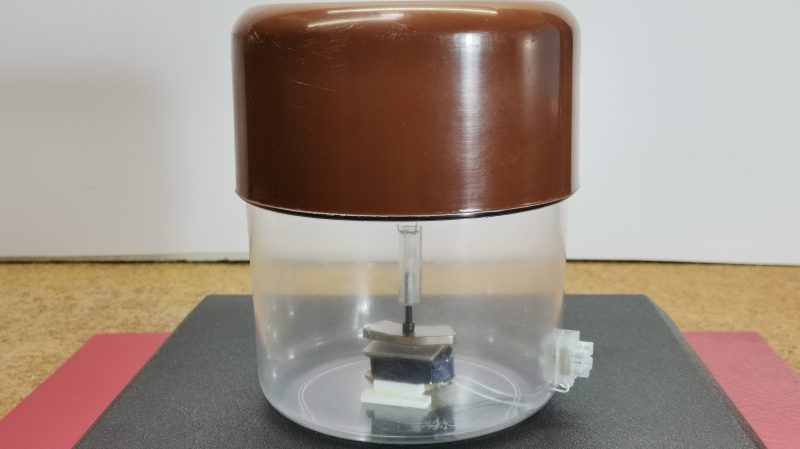If you want to know what’s going on with the ground, geologically speaking, a geophone is a great tool to have. It lets you listen in on the rumbles and grumbles beneath your feet, and can give you great insight into matters of seismic importance. [mircemk] has designed a very capable geophone that’s simple enough for you to build at home.
The geophone relies on a mass suspended upon a spring inside a chamber, which as you might imagine, will move when shaken by seismic vibrations. The mass is in fact a plastic rod, fitted with an iron nut and a magnet on the end.
This is mounted above a coil, which is fixed to the base of the chamber. Thus, when the chamber is shaken by seismic activity, the mass moves relative to the coil, with the coil picking up the varying magnetic field as it dances around.
The YouTube video does a great job of explaining the concepts involved and how to practically build the device. [mircemk] has also had some other great projects featured on Hackaday before, too.

















All I’m going to pickup is the vibration caused by snowplowing the street in front of my apartment. I’m on the 16th floor (by height, not floor number), and the building is a tuning fork for snow clearing.
Tempting though. Wire up a pico to monitor it.
Hmm. Weekend project….
Great project as long as you don’t have any nocturnal neighbors that could distort the results. :D
That would be amusing to be honest.
“What’s this weird pattern that shows up every couple of days between 9:30pm and 11:30, and lasts for approximately 20 minutes”
“Don’t ask”
I’ve been meaning to play with geophones. I have 1, but I think if I had 3 I could triangulate movement in the house since I have hardwood floors.
On the other hand I think now just about any good accelerometer will be just as sensitive?
You need to add GPS for accurate positioning (sensor station learns it’s real location by averaging GPS data over time) and timing, then send out the time stamped data via wifi or lora to a central station for number crunching. FFT the data streams and feed into a neural network (based on a speech to text model architecture) to identify vibration sources, their location, and even their motion vector if mobile. The above also gives you the advantage of being able to send GPS correction data out over radio from the sensor stations, they become fixed reference points for other systems needing accurate positioning (cm scale!). And…. while you are going to that trouble you may as well add a weather station to the installation too.
For a geophone, the preamp, shielding, and signal conditioning is at least as important as the sensor, and (IMHO) the hardest to do well. A preamp to operate near DC, with low input impedance, high dynamic range, and operating at the thermal noise floor, is not trivial to do.
I’d love to see how this is treated in this rig, but I don’t see it in this write-up. Waiting for the next installment…
You’ll be disappointed. He uses an off the shelf Amazon/eBay LM358 base opamp module. (I went to his youtube channel to find part 2.)
I too was hoping to see a seismic signal conditioning module. Analog at that level is a bit beyond me but I’d like to learn.
http://vlf.it you will find some useful information for near dc opamps
e. g. http://www.vlf.it/minimal/minimal.htm
Maybe use fiber instead?
https://spectrum.ieee.org/earthquake
Aw shoot, I seem to have misplaced my roll with hundreds of kilometers of optic fiber. Maybe next time.
Fun project but you’d get better results with an accelerometer chip.
All issues with signal conditioning aside, the low resonant frequency of the spring-mass system is going to be problematic in terms of producing useful quantitative data. Spurious resonances are a known problem/phenomenon in this realm and it can be compensated/adjusted but you have to know it’s there. Like most mechanical accelerometers, any kind of low fn input gives a wildly amplified result, whereas high frequency may be damped completely by the mechanical impedance mismatch.
What is the state of low frequency SDRs? Like 0-1MHz.
I have purchased an up-converter that is supposed to bump 0-nMz up to the 100MHz+ band, which is within a cheapo standard SDR USB dongle range. But I’ve not tried it yet.
While my application is a passive sonar system, I can see benefit from having advanced analysis capability for a DIY geophone. Such as identify the difference between the garbage truck and a small earthquake.
I’ve read years ago about a shallow well as being isolated enough to get away from most surface transportation noise. We use to have trains right through town and at 4 blocks away I’d feel the rumble and sometimes a clip lead clipped to the shelf edge which hung free above the bench would dance visibly when the sound of the train was not heard. Freaked me out the first time I saw it. The last quake in Indiana had my keyboard/monitor bouncing right in front of me hands off, it’s on an extension arm which has a “rigid” mount.
This reminded me of a page I saw a few years ago. You can use a linear hall sensor too.
https://seismograph.tripod.com/linearsensors.html
https://seismograph.tripod.com/distancecalibrator.html